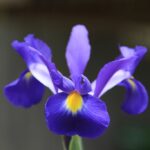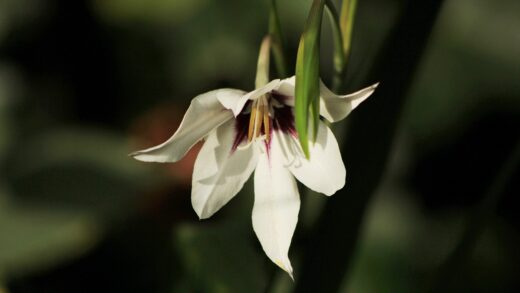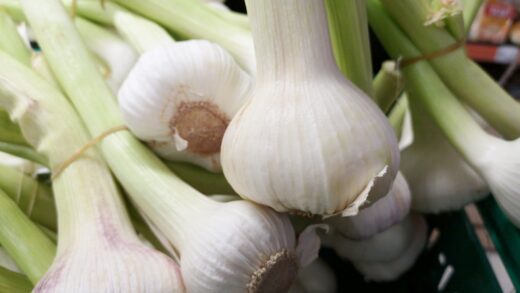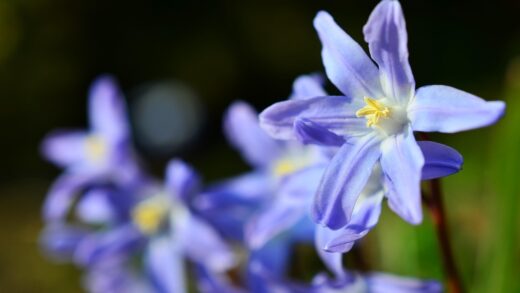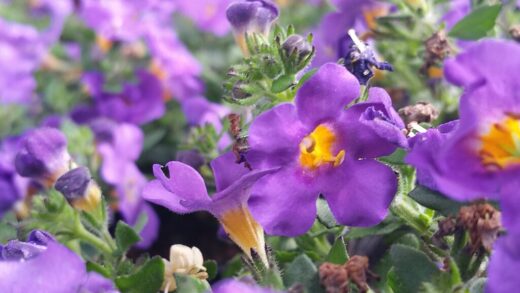One of the most appealing attributes of American pokeweed for the low-maintenance gardener is its remarkable resistance to diseases and pests. As a robust native plant, it has co-evolved with its environment and possesses a strong natural defense system. Its own chemical composition, which makes it toxic to mammals, also seems to deter many common garden pests. Consequently, you will likely find that your pokeweed remains healthy and vigorous throughout the growing season with very little intervention. It is not a plant that you will need to spray with fungicides or pesticides; in fact, doing so would be contrary to its role as a tough, self-sufficient member of the garden ecosystem.
While the plant is generally trouble-free, it is not completely immune to all potential issues. In certain conditions, particularly in periods of high humidity, cool temperatures, and poor air circulation, it can be susceptible to some common fungal diseases. These typically manifest as spots on the leaves or a powdery coating. The most common culprits are diseases like leaf spot and powdery mildew. However, these issues are almost always cosmetic in nature and rarely pose a serious threat to the overall health of such a vigorous plant. The best defense against them is prevention through proper siting and culture.
On the pest front, American pokeweed is rarely a primary target. Most leaf-chewing insects, such as caterpillars and beetles, tend to avoid the toxic foliage. You will not find it decimated by the pests that plague more common garden vegetables and ornamentals. Occasionally, you might find aphids on the tender new growth or on the flower stalks, but significant infestations are uncommon. The plant’s rapid growth rate usually allows it to outpace any minor damage caused by sap-sucking insects.
The most effective strategy for dealing with any potential health issues in American pokeweed is to focus on providing it with the right growing conditions from the start. This means choosing a site with good air circulation, providing it with enough space to grow to its full size, and avoiding overwatering or over-fertilizing, which can create weak growth that is more susceptible to problems. By working with the plant’s natural resilience rather than against it, you can ensure that it remains a healthy and dramatic focal point in your garden for years to come, largely untroubled by the common afflictions of other plants.
Common fungal issues
Although American pokeweed is highly resilient, it can occasionally fall prey to a few common fungal diseases, particularly when environmental conditions are favorable for pathogen growth. The most likely issue you might encounter is leaf spot. This is a general term for a variety of fungal pathogens that cause spots to appear on the foliage. The spots may vary in color—from tan to dark brown or black—and they sometimes have a distinct border. While the appearance of these spots can be alarming, they rarely cause significant harm to a large, established pokeweed plant.
Another potential fungal visitor is powdery mildew. This disease is easily identified by the characteristic white, powdery or dusty-looking patches that appear on the surfaces of the leaves and sometimes on the stems. Powdery mildew thrives in conditions of high humidity, particularly when days are warm and nights are cool. It tends to be more of a problem on plants that are growing in shady, damp locations with poor air circulation. As with leaf spot, it is primarily a cosmetic issue and is unlikely to seriously impact the plant’s long-term health.
Prevention is always the best defense against these fungal problems. Ensure you provide your pokeweed with adequate spacing from other plants to promote good air movement around the foliage. This helps the leaves to dry out more quickly after rain or morning dew, making it harder for fungal spores to germinate and take hold. Also, try to water the plant at its base using a soaker hose or drip irrigation rather than overhead sprinklers. Watering from above wets the leaves, creating the ideal damp environment for fungal diseases to develop.
If you do find that a fungal issue has taken hold and the appearance is bothering you, the best course of action is sanitation. Prune off and dispose of the most heavily affected leaves to reduce the number of fungal spores available to spread. Be sure to throw this material in the trash, not in your compost pile. At the end of the season, after the plant has died back, be meticulous about cleaning up all the fallen leaves and dead stems from around the base of the plant. This will remove the overwintering fungal spores and help to ensure a healthier start the following spring.
Pest resistance and minor threats
The inherent toxicity of American pokeweed is its greatest defense against pests. The complex chemical compounds present in its leaves, stems, and roots make it unpalatable and poisonous to most herbivorous insects and mammals. This is why you will rarely, if ever, see significant feeding damage from common garden pests like deer, rabbits, or most caterpillars. This built-in chemical defense system makes it an excellent choice for gardens where animal browsing is a persistent problem. The plant effectively protects itself without any need for chemical sprays or physical barriers.
Despite its powerful defenses, a few specialist or generalist pests may occasionally be found on pokeweed, though they rarely cause significant damage. Aphids are perhaps the most likely culprits. These small, sap-sucking insects may colonize the tender tips of new growth or the succulent flower stems. A small aphid population is generally not a cause for concern and will often be controlled by natural predators like ladybugs and lacewings. If an infestation becomes heavy, a strong spray of water from a hose is usually sufficient to dislodge them.
You might also occasionally notice minor damage from leaf miners or other small insects, which may appear as stippling or winding trails within the leaves. However, due to the plant’s incredibly rapid growth rate, it produces new leaves so quickly that this minor damage is soon covered up and becomes unnoticeable. The plant’s ability to outgrow minor pest issues is another aspect of its impressive resilience. It simply produces new, healthy tissue faster than pests can damage the old tissue.
In summary, the approach to pest management for American pokeweed should be one of observation rather than intervention. It is a plant that hosts a very low pest load. By avoiding the use of broad-spectrum pesticides in your garden, you can encourage a healthy population of beneficial predatory insects that will take care of any minor pest issues that may arise on the pokeweed and other nearby plants. This creates a balanced, self-regulating garden ecosystem where the pokeweed can thrive without chemical assistance.
The importance of air circulation
Good air circulation is arguably the single most important factor in preventing the few diseases that can affect American pokeweed. Fungal pathogens like powdery mildew and various leaf spots thrive in stagnant, humid air. When leaves remain wet for extended periods, it gives fungal spores the perfect opportunity to germinate and infect the plant tissue. Providing ample space around your pokeweed ensures that gentle breezes can flow freely through its foliage, drying the leaves quickly after rainfall and reducing the overall humidity in the plant’s canopy.
The most critical step in ensuring good air circulation is proper spacing at the time of planting. It can be tempting to place a small seedling closer to other plants than recommended, but you must resist this urge and plan for the plant’s mature size. A single pokeweed can grow to be very large and dense, so planting it at least one and a half to two meters away from other large plants, fences, or buildings is crucial. This spacing prevents the creation of a pocket of still, moist air that would be an open invitation for fungal diseases.
Strategic pruning can also be used to improve air circulation within a particularly dense pokeweed plant. As the plant grows in the spring, it will send up multiple shoots from its base. You can choose to thin these shoots, selecting the strongest three to five and removing the rest at the ground level. This opens up the center of the plant, allowing more light and air to penetrate the canopy. This not only reduces the risk of disease but can also create a more aesthetically pleasing, open, and architectural form.
The location you choose in your garden also plays a significant role. Planting pokeweed in a low-lying, damp spot with little air movement is asking for trouble. Instead, select a more open site where it can benefit from prevailing winds. Avoiding planting it in a crowded corner or right up against a solid wall will contribute significantly to its long-term health. By simply considering the flow of air, you are employing the most effective preventative medicine against the most common diseases of this otherwise robust plant.
Environmental stress factors
While diseases and pests are minor concerns, American pokeweed can sometimes show signs of stress due to adverse environmental conditions. These are often misinterpreted as signs of a disease. For example, leaf scorch can occur during periods of intense sun and heat, especially if the plant is not yet fully established and is experiencing some water stress. This may appear as brown, crispy edges on the leaves. The solution is not a fungicide, but ensuring the plant has adequate moisture during extreme weather, particularly in its first year.
Poor drainage is another significant environmental stressor. Although pokeweed is adaptable, it will not tolerate having its roots sitting in waterlogged, anaerobic soil for extended periods. This condition can lead to root rot, which is one of the few issues that can actually kill an established plant. The symptoms of root rot above ground can be ambiguous, including yellowing leaves, wilting, and stunted growth. The best way to avoid this is through proper site selection and soil preparation, ensuring the chosen location is well-drained from the outset.
Soil compaction can also cause stress. If the soil around the base of the plant becomes heavily compacted from foot traffic or machinery, it can restrict the roots’ access to oxygen and water, leading to a general decline in the plant’s vigor. To alleviate this, you can gently cultivate the soil surface and apply a layer of organic mulch. The mulch encourages earthworm and microbial activity, which will naturally help to decompact the soil over time, and it also helps to prevent future compaction.
Finally, while pokeweed is tolerant of a wide range of soils, extreme deficiencies or toxicities in the soil could theoretically cause problems, although this is very rare. For instance, very high soil salinity or extreme pH levels could potentially stress the plant. However, given that pokeweed is often seen thriving in poor-quality urban and roadside soils, it has a very high tolerance for suboptimal conditions. In almost all cases, if a pokeweed plant looks unhealthy, the cause is more likely to be a physical or environmental issue like poor drainage or lack of water during establishment, rather than a classic disease or pest.



